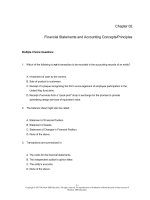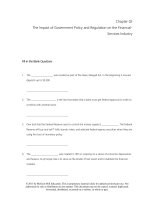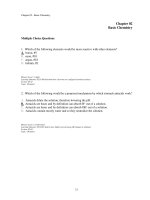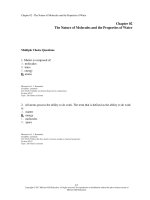Understanding financial statements 11th edition fraser test bank
Bạn đang xem bản rút gọn của tài liệu. Xem và tải ngay bản đầy đủ của tài liệu tại đây (153.99 KB, 10 trang )
Test Questions and Solutions
Chapter 1
True-False
1. A firm’s annual report contains only two pieces of information: the financial
statements and the notes to the financial statements.
2. The SEC regulates U.S. companies that issue securities to the public and
requires the issuance of a prospectus for any new security offering.
3. The FASB has congressional authority to set accounting policies.
4. The European Union began requiring publicly traded companies to use U.S.
GAAP in 2005.
5. External auditors are required to audit the internal control assessment of the
company as well as the financial statements.
6. Congress passed the Sarbanes-Oxley Act of 2002 in hopes of ending future
accounting scandals and renewing investor confidence in the marketplace.
7. The Management Discussion and Analysis is of potential interest to the analyst
because it contains information that cannot be found in the financial data.
8. Information that is significant enough to make a difference in a decision is
considered to be immaterial.
9. The time period assumption assumes a two year time frame with interim
reporting occurring daily and weekly.
10. GAAP-based financial statements are prepared according to the accrual basis
of accounting.
Fill in the Blank
1. The
annually.
requires all public companies to file a Form 10-K report
2. A corporate annual report contains
financial statements.
3.
is responsible for the preparation of the financial statements,
including the notes, and the
attests to the fairness of the
presentation.
4. The
was passed in 2002 and was one of the most sweeping
corporate reforms since the Securities Act of 1934.
5. The
is a document used to solicit shareholder votes.
6. The
Assumption is the assumed unit of measurement when
preparing financial statements.
7. The cash basis of accounting recognizes
recognizes
when cash is paid.
when cash is received and
8. The sharper and clearer the picture presented through the financial data and the
closer that picture is to financial reality, the higher the
financial
statements and reported earnings.
9. One of the generally accepted accounting principles that provide the foundation
for preparing financial statements is the
principle.
10. Management exercises control over the budget level and timing of
expenditures.
Multiple Choice
1. What information would not be found in a firm’s annual report?
a. Notes to the financial statements.
b. Financial Reporting Rulings.
c. Auditor’s report.
d. High and low stock prices.
2. Which agency requires the filing of Form 10-Ks, Form 10-Qs and Form 8-Ks?
a. FASB.
b. IASB.
c. SEC.
d. GAAP.
3. Which of the following statements is true?
a. Foreign firms registered with the SEC may file reports based on IFRS.
b. U.S. firms registered with the SEC may file reports based on IFRS.
c. The European Union requires firms to report based on GAAP.
d. Foreign firms registered with the SEC may file reports based on IFRS
only if they reconcile all amounts to GAAP.
4. Which financial statement presents the results of operations?
a. Balance sheet.
b. Statement of financial position.
c. Income statement.
d. Statement of cash flows.
5. Which financial statement shows the assets, liabilities and stockholders’ equity
of the firm on a particular date?
a. Statement of stockholders’ equity.
b. Statement of cash flows.
c. Earnings statement.
d. Balance sheet.
6. Which financial statement provides information about operating, financing and
investing activities?
a. Statement of financial position.
b. Statement of cash flows.
c. Statement of stockholders’ equity.
d. Income statement.
7. What information can be found on a statement of stockholders’ equity?
a. A reconciliation of the cash account and the retained earnings account.
b. A reconciliation of the beginning and ending balances of all accounts that
appears in the stockholders’ equity section of the balance sheet.
c. A reconciliation of the operating, investing and financing activities of a
firm.
d. A reconciliation of net profit or loss and the cash account.
8. What basic financial statements can be found in a corporate annual report?
a. Balance sheet, income statement, statement of shareholders' equity, and
statement of cash flows.
b. Balance sheet, auditor's report and income statement.
c. Earnings statement and statement of retained earnings.
d. Statement of cash flows and five-year summary of key financial data.
9. What is an unqualified audit report?
a. A report stating that the auditors are not qualified to report on a firm.
b. A report that states the financial statements are in violation of GAAP.
c. A report that states that departures from GAAP exist in the firm’s
financial statements.
d. A report that states the financial statements are presented fairly, in all
material respects, and are in conformity with GAAP.
10. What is a qualified report?
a. A report stating that the auditors are not qualified to report on a firm.
b. A report that states the financial statements are in violation of GAAP.
c. A report that states that departures from GAAP exist in the firm’s
financial statements.
d. A report that states the financial statements are presented fairly, in all
material respects, and are in conformity with GAAP.
11. What organization has the authority to register, inspect, and discipline auditors
of all publicly owned companies?
a. Public Company Accounting Oversight Board.
b. SOX.
c. Congress.
d. FASB.
12. According to Section 302 of the Sarbanes-Oxley Act, who must certify the
accuracy of the financial statements of a public company?
a. Public Company Accounting Oversight Board.
b. SEC.
c. External auditor.
d. CEO and CFO.
13. All of the following items should be discussed in the management discussion
and analysis except for:
a. Anticipated changes in the mix and cost of financing resources.
b. The market value of all assets.
c. The internal and external sources of liquidity.
d. Unusual or infrequent transactions that affect income from continuing
operations.
14. Which of the following is an internal source of liquidity?
a. Borrowing.
b. Sales of stock.
c. Gifts and donations.
d. Sales of products or services.
15. Which of the following is an external source of liquidity?
a. Sales of services.
b. Repurchase of stock.
c. Borrowing.
d. Sales of products.
16. Which of the following is not a condition that must be met for an item to be
recorded as revenue?
a. Revenues must be earned.
b. The amount of the revenue must be measurable.
c. The revenue must be received in cash.
d. The costs of generating the revenue can be determined.
17. How are revenues and expenses recognized under the accrual basis of
accounting?
a. Revenues are recognized when cash is received and expenses are
recognized when cash is paid.
b. Revenues and expenses are recognized equally over a twelve month
period.
c. Revenues and expenses are recognized based on the choices of
management.
d. Revenues are recognized in the accounting period when the sale is made
and expenses are recognized in the period in which they relate to the sale of
the product.
18. In what industry would it be expected that companies would spend a
significant amount on research and development activities?
a. Pharmaceutical.
b. Clothes retailer.
c. Groceries.
d. Wholesale distributor of computer parts.
19. Which of the following items is a discretionary expenditure?
a. Union wages.
b. Factory building to produce inventory.
c. Advertising.
d. Taxes.
20. Which of the following statements is false with regard to quality of financial
reporting?
a. Financial statements should reflect an accurate picture of a company’s
financial condition and performance.
b. It is unlikely that management can manipulate the bottom line due to the
regulations in place to enforce GAAP.
c. Financial information should be useful both to assess the past and predict
the future.
d. The closer that the picture presented through the financial data is to
reality, the higher the quality of financial reporting.
Short Answer
1. Write a short essay explaining the following statement: “Unfortunately, there are
mazelike interferences in financial statement data that hinder understanding the
valuable information they contain.”
2. Describe the relationship between the FASB and the SEC.
3. Explain why the notes are an integral part of the financial statements.
4. Discuss the impact that the Sarbanes-Oxley Act of 2002 had on internal
auditing.
5. Define internal and external sources of liquidity. What is a material deficiency in
liquidity? If a firm has a material deficiency in liquidity what should be reported in
the management discussion and analysis?
6. What types of information may be missing or hard to find in the financial
statements?
7. Explain why the characteristics of comparability and consistency are important
in financial reporting?
8. Write an essay discussing the two key principles that are the foundation of the
accrual basis of accounting.
Solutions - Chapter 1
True-False
1.
2.
3.
4.
5.
F
T
F
F
T
6. T
7. T
8. F
9. F
10. T
Fill in the Blank
1. SEC
2. Four
3. Management, auditor’s report
4. Sarbanes Oxley Act
5. Proxy statement
6. Monetary unit
7. Revenues, expenses
8. Quality
9. Matching
10. Discretionary
Multiple Choice
1.
2.
3.
4.
5.
b
c
a
c
d
6.
7.
8.
9.
10.
b
b
a
d
c
11.
12.
13.
14.
15.
a
d
b
d
c
16.
17.
18.
19.
20.
c
d
a
c
b
Short Answer
1. The following items make it more difficult for a user of financial statements to
understand the financial data:
Quantity of information
Clean audit reports do not mean the firm will not fail
Complex accounting policies that may be confusing
Accounting rules are constantly changing
Management has discretion in presenting financial information
Some information is not available or is difficult to find in the financial
statements
2. The FASB and the SEC work closely together in the development of accounting
policy, with the SEC playing largely a supportive role. Pressures from the private
sector have caused controversy at times. Congress has given accounting
rulemaking authority to the SEC, who, in turn, has passed that role to the FASB.
The SEC maintains veto power over any rule written by the FASB. Reporting
companies must use the rules written by both the SEC and the FASB and if these
companies do not like the rules they will most likely lobby their congressmen to
force the SEC to change those rules.
3. The notes must be read in order to understand the presentation on the face of the
financial statements. Key information that can be found in the notes includes a
summary of the firm’s accounting policies and any changes that may have been
made to those policies during the reporting period. Detail about particular accounts
such as inventory, property, plant and equipment, investments, long-term debt, and
equity accounts can be found in the notes. Information about acquisitions,
divestitures, pension and stock option plans, leases, legal proceedings, income
taxes, contingencies and commitments, quarterly results of operations and
operating segments can also be found in the notes.
4. Section 404 of SOX requires companies to include in their annual reports a
statement regarding the effectiveness of internal controls and the disclosure of any
material weaknesses in a firm’s internal controls system. This requirement has
greatly boosted the need for internal auditors and SOX compliance specialists, but
more important, has enhanced the value of the internal audit function within
companies, as businesses have strengthened internal controls in response to SOX.
5. Internal sources of liquidity include the cash received from selling products and
services; external sources of liquidity include cash received from outside sources
such as borrowing or selling the firm’s stock to raise funds. A material deficiency
in liquidity means that a firm may not have enough cash to make it through another
operating cycle. If a firm has a material deficiency the firm must discuss how this
deficiency will be remedied so that bankruptcy will hopefully be prevented.
6. Missing and hard to find information includes such intangibles as employee
relations with management, the morale and efficiency of employees, the reputation
of the firm with its customers, the firm’s prestige in the community, the
effectiveness of management, provisions for management succession, and potential
exposure to changes in regulations—such as environmental or food and drug
enforcement. Much information is available in the notes to the financial statements,
but may be difficult for the user to find and analyze. Complicated financing
schemes, while revealed in the notes, may be impossible for many users to
understand without an extensive background in accounting.
7. The characteristics of comparability and consistency require companies to use
the same accounting methods and choices from one period to another. This allows
users to compare financial information of an entity to other entities as well as
comparing financial information of that entity to itself from one time period to
another. Changes in accounting methods and choices can distort trends that are
useful when trying to predict the future of a firm.
8. The two key principles are the revenue recognition and the matching principle.
The revenue recognition principle requires that four conditions be met for a
transaction to be recorded as a revenue item. The four conditions are (1) the
revenues must be earned (the sale is complete), (2) the amount of the revenue must
be measurable, (3) the costs of generating the revenue can be determined, and (4)
the revenue must be realizable.
The matching principle requires revenues and expenses to be properly matched in
the same time period. Once revenue has been recognized in an accounting period,
expenses incurred to generate that revenue need to be recorded in the same
accounting period. Revenues and expenses, therefore, are recorded when events
take place, without regard to receipt or payment of cash.









